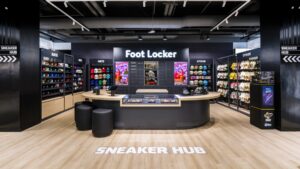Foot Locker Faces Challenges Amid Sneaker Industry Discounts – What It Means for Investors
At Extreme Investor Network, we continuously provide our readers with the most insightful analyses of market trends and company performances. This week, we turn our attention to Foot Locker, a prominent player in the sneaker retail space, as it navigates a landscape filled with deep discounts and strategic adjustments.
A Deep Dive into Recent Performance
On Wednesday, Foot Locker announced expectations for another year rife with aggressive discounts in the sneaker industry. The retail giant’s largest brand partner, Nike, is in the midst of a significant overhaul, which requires it to rely heavily on markdowns to clear lingering inventory. This adjustment has a ripple effect throughout the entire sneaker marketplace.
A Mixed Bag for Holiday Quarter
Foot Locker’s recent holiday quarter results displayed a dichotomy that has analysts re-evaluating their outlooks. While the company’s earnings surpassed Wall Street expectations, its revenue fell short, leading to a complex narrative for investors:
- Earnings Per Share: Adjusted EPS of 86 cents, beating the anticipated 72 cents.
- Revenue: Reported at $2.25 billion, down from the expected $2.32 billion.
The company posted a net income of $49 million, or 51 cents per share, representing a significant recovery from a loss of $389 million in the same quarter the previous year. However, it’s important to note that sales dropped nearly 6% from $2.38 billion last year. Analysts attribute part of this decline to an extra week of sales in the prior year, which complicates year-over-year comparisons.
Looking Ahead: Fiscal 2025 Projections
Foot Locker is bracing for a challenging fiscal 2025, forecasting profits below Wall Street estimates and comparable sales growth of only 1% to 2.5%. However, the upper end of this projection slightly outperforms analysts’ expectations of a 1.9% increase. The juxtaposition of these forecasts indicates a cautious optimism, though promotional pressures within the sneaker sector remain an ongoing concern.
CEO Mary Dillon expressed confidence in the company’s strategic initiatives, specifically the "Lace Up Plan," aimed at revitalizing the brand’s image and operations. Despite anticipated consumer and category pressures, Dillon emphasized the positive indicators such as gross margin expansion and improved free cash flow as signs that their strategies are taking hold.
The Ongoing Nike Challenge
Nike’s current strategy, which includes substantial promotional activity and the introduction of new products, is influencing Foot Locker’s performance. As it stands, Nike represents around 60% of Foot Locker’s sales, making its success crucial to the retail giant’s health.
While Dillon describes the relationship with Nike as "strong and fully reset," executives acknowledge that Nike’s strategy poses challenges. As Nike works to liquidate old inventory, the uneven pricing between Foot Locker’s and Nike’s direct-to-consumer channels may drive customers directly to Nike’s website, impacting Foot Locker’s sales.
Strategic Innovations and Brand Diversification
Faced with these challenges, Foot Locker has begun diversifying its brand offerings. Recent sales figures indicate a growing partnership with brands such as On Running, Hoka, and Adidas, which have all seen substantial increases. This diversification helps mitigate risks associated with dependence on any single brand, especially one as pivotal as Nike.
Additionally, Foot Locker is investing heavily in remodeling its stores to enhance customer experience. The company has introduced eight “reimagined” locations and plans to refresh another 80 by 2025. This strategy aims to sustain sales in an environment where mall traffic is declining.
What This Means for Investors
As Foot Locker navigates a complex landscape filled with promotional pressures and strategic diversification, here are key takeaways for investors considering this stock:
-
Monitor Brand Partnerships: Pay attention to Foot Locker’s evolving relationships with key partners, particularly Nike. Changes in this dynamic could lead to significant shifts in revenue.
-
Sales Strategy Impact: Focus on the effectiveness of Foot Locker’s promotional strategies and store refreshes. Their ability to adapt to consumer preferences will be crucial.
- Financial Guidance: As Foot Locker anticipates a reduction in store count and square footage, weigh this against its projected sales growth and adjusted EPS estimates to assess overall stability.
In conclusion, while Foot Locker faces headwinds in a shifting retail environment, its strategic initiatives provide a foundation for potential growth. The challenges ahead are formidable, but for savvy investors, the stock may represent an intriguing opportunity worth further exploration. Stay tuned with Extreme Investor Network for ongoing updates and deeper analyses that keep you ahead of the curve in the business landscape.

